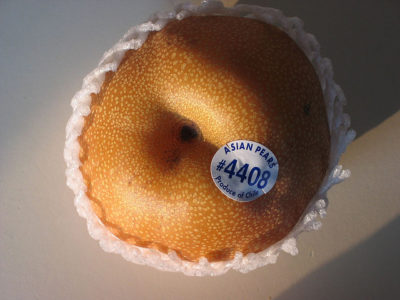
Asian pear blossoms - Photo by nordique
The Asian pear originates from China, Japan and Korea but is now also cultivated outside Asia.
The Asian pear (or Nashi pear) is sometimes called ‘Apple pear’, but it is not a cross between apples and pears, as this name suggests. It’s a pear that rather looks like an apple.
Names
Scientific
Pyrus pyrifolia
English
Apple pear
Asian pear
Chinese pear
Japanese pear
Korean pear
Nashi pear
Sand pear
Taiwan pear
Dutch
Aziatische peer
Nashi-peer
Zandpeer
Spanish
Nashi
Pera asiática
Pera coreana
Pera de arena
Pera de Taiwán
Pera japonesa
Pera manzana
Pera nash
Pera oriental
French
Nachi
Nashi
Poire asiatique
Poire cristal
Poire des sables
Poire japonaise
Pomme-poire
German
Apfel-Birne
Asiatische Birne
Chinesische Birne
Japanische Birne
Koreanische Birne
Kumoi
Nashi
Nashi-Birne
Italian
Nashi
Pera-mela
Taxonomy
Order
Rosales
Family
Rosaceae
Genus
Pyrus
Species
Pyrus pyrifolia (Asian pear)
Basic information and facts
Origin:
The Asian pear originates from China, Japan and Korea.
Distribution:
Asian pears are cultivated in East Asia (Japan, Korea, China, India, Nepal, etc.) but are now also grown in other countries outside Asia, including USA, Cyprus, Chili, New Zealand and Australia.
Deciduous or evergreen:
Deciduous
Flowers:
The white flowers of the Asian pear are a beautiful sight in early spring.
Leaves:
Fruits:
Asian pears do not have a pear-shape but rather look like large apples.There are two types, with a brownish-yellow color (Akanashi)and with a yellow-green color (Aonashi). The fruits are crisp and juicy like apples but have a different texture.
Climate and weather:
These trees are cultivated in temperate climates.
Pollination:
The trees are pollinated by bees. While Asian pears are partially self-fruitful, better fruit production is obtained when two or more cultivars are planted together.
Height:
Spacing:
Spacings used range from 2.25 x 4.5 meters to 4.5 x 6 meters.
Propagation:
Asian pears are usually propagated by grafting onto other Pyrus species.
Insect pests:
Codling moth (Carpocapsa pomonella) and some other pests including Pear psylla (Psylla pyricola) and two-spotted spidermites.
Diseases:
Fire blight, bacterial canker, crown rot.
Harvesting:
Hand picking of fruits when they are fully ripe. They can be kept for several months in cool storage.
Uses:
Asian pears are used fresh as a hand fruit.
Crop categories
Cool temperate crops
Fruits
Mediterranean crops
Minor crops
Subtropical crops
Temperate crops
Pictures

Asian pear - Photo by acloudman

Asian pear - Photo by elias_daniel

Asian pear - Photo by Vegan Feast Catering

Asian pear - Photo by AndWat

Asian pear - Photo by nordique
